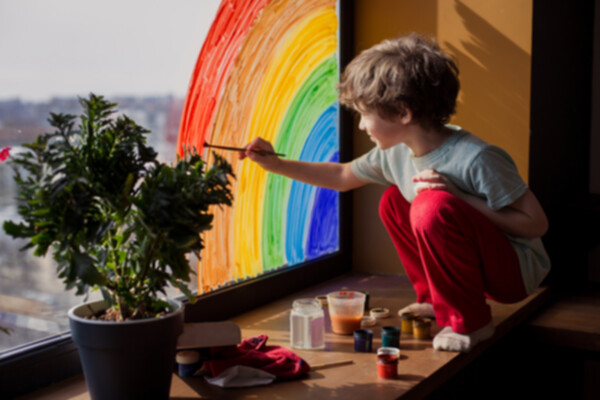Can drawings express our emotional state? How can we interpret people’s drawings? Discover the meaning behind these drawings.

When a child is faced with a blank piece of paper, they usually draw all kinds of reasons: things they like or dislike in the world around them, people who are important in their life for different reasons, among other aspects. The people and their drawings They can be interpreted to see what their personality and psychology are like. Discover how drawing and feelings or emotions are connected.
Do people’s drawings really reflect our personality?
A team of professors and psychologists from the University of the Basque Country has published a study that determines how drawings of people They are a good tool to assess the conceptual development of the little ones, especially from 5 years old.
To prepare this report, among other examples, the drawings which nearly 120 boys and girls between 4 and 7 years old conducted about the life of plants. From them, it was determined that the presence of representations such as rain, the sun or clouds shows that children have a more precise knowledge about living beings – these are elements that plants need to survive.
Not in vain, it is a technique that is already used taking as reference a series of graphic indicators that determine the presence or level of some psychological traits such as egocentrism, insecurity, self-esteem, motivation for learning or even presence of social relationship problems.
In the same way, there is a psychology in drawing that can tell us what we are like, what traits predominate in our personality, as well as what we are suffering right now. So much so that on many occasions, it can be interesting to analyze our drawings of people, animals, landscapes, among other elements.
Keys for interpreting drawings of people
It is also important to know that there are no exact rules and many can influence elements in the drawing although a series of aspects can be taken into account to analyze them in detail:
- How they approach making the drawing, the way they hold the pencils, if they ask questions before starting, etc.
- The elements that make it up: Whether they have been previously requested or if you have been allowed a free theme drawing.
- The space or size that the drawing occupies on the paper, as a whole and each element separately and with respect to other elements.
- The shape of the drawing: If it presents predominantly straight or curved lines.
- The colors you use
- The line: If it is strong and firm, if excess pressure is perceived or not, if they are continuous or discontinuous, if they intersect, etc.
- The corrections you make and how you deal with them.
The psychology of drawing in children
According to a British study by the Institute of Psychiatry at King’s College London, children’s drawing skill 4 years old is an indicator of the intelligence he will have at 14.
A research team from King’s College London has carried out a study that has allowed us to examine a sample of 7,752 pairs of monozygotic and heterozygous twins. Children aged 4 years and then 14 years participated, in whom, through a language test, the drawing ability (draw-a-child test). Each drawing has been assigned a score from 0 to 12, taking into consideration the particular inclusion of the figures.
According to research, some children have shown greater attention to details, such as draw a human figure with nose, ears and eyes. This precision could be synonymous with greater intelligence compared to those children who have drawn with fewer details.
Psychiatrist Rosalind Arden, author of the study published in Psychological Sciencehas stated: “This type of test was created in the 1920s to establish the intelligence of young children, which is why the correlation between the results and intelligence was predictable in the 4-year-old group. What was surprising was the correlation with intelligence measured after a decade”.

Indeed, at four years old, a high score in el drawing test corresponds to a high score on the intelligence test. However, the novelty of the English research lies in the fact that it has revealed that this same test, repeated at age 14, demonstrates that children with high scores at age 4 maintain this standard unaltered.
What happens, therefore, to children who do not have this ability to draw? Will they have problems during adolescence? Rossalind Arden assures that: “The correlation is moderate, so our results are interesting, but that does not mean that parents should worry if their child draws poorly. The ability to draw does not determine intelligence, but there are many factors, both genetic and environmental, that influence intelligence in adult life.”.
Based on this study, we know that genes influence graphic ability. In fact, the drawings of identical twins were very similar to each other compared to those of non-identical twins. Although the results of the test at age 14 have shown how this genetic link remains unchanged over the years.
What is the meaning behind people’s drawings?
On some occasions the psychologist can carry out a drawing evaluation to be able to try to visualize what the problems of their patients are in very broad terms. Among these interpretations we can highlight the following.
-
Animals
Those who do drawings of animals They may be more sensitive to living creatures. Furthermore, the type of animal that is drawn says a lot about the mood of the person who draws it. For example, an adult or child drawing a ‘weak or small’ animal may indicate a lack of confidence and introverted tendencies. On the other hand, aggressive animals may reflect feelings of assertiveness.

-
Faces
When the drawing of faces, this is usually a good indication of the mood of the person who drew it. For example, a pretty face suggests that you see the good in others, while strange faces probably imply distrust of others. Finally, comical faces demonstrate the desire to be the center of attention. Childish scribbles of faces suggest need. The profiles indicate that you are an introvert.
-
People
The drawings of people They can have many meanings. When people are drawn without feet this can imply a feeling of not belonging or having no roots. Not drawing hands implies a feeling of not being able to do things. By only doing people in profile this can be a sign that the person doesn’t like how they look.
-
stars
Drawing stars can indicate a feeling of hope for the future and a certain optimism towards life.
-
Trees
Trees usually represent our ego and ambitions. So much so that those that have many leaves or fruits can indicate that they feel loved. Bare branches can indicate depression and rootless trees can be a sign that you feel like no one is there for you.
There are many interpretations of drawings of people Despite this, these types of comments on the psychology of drawing people are not a science and therefore can only reveal very generalized aspects of personality. In all cases, these interpretations must be made by professional psychologists who know the techniques and knowledge in this regard.








